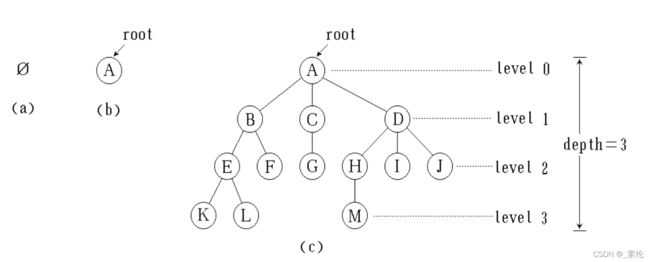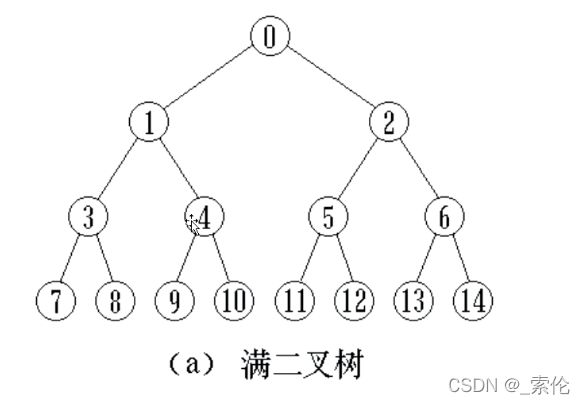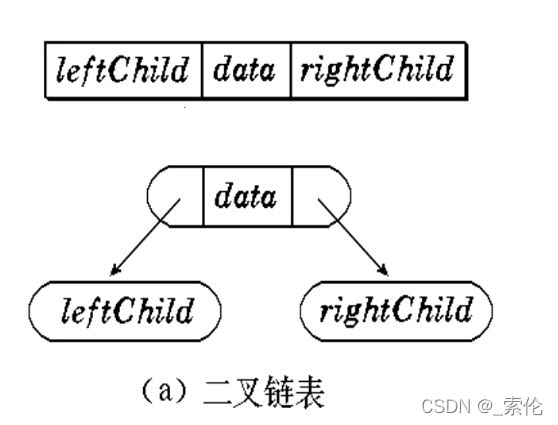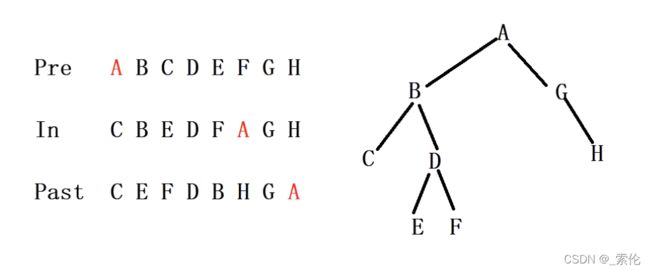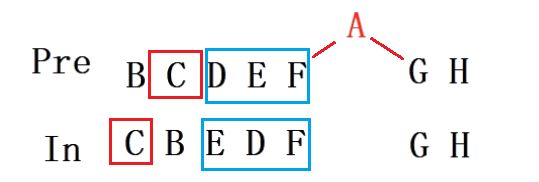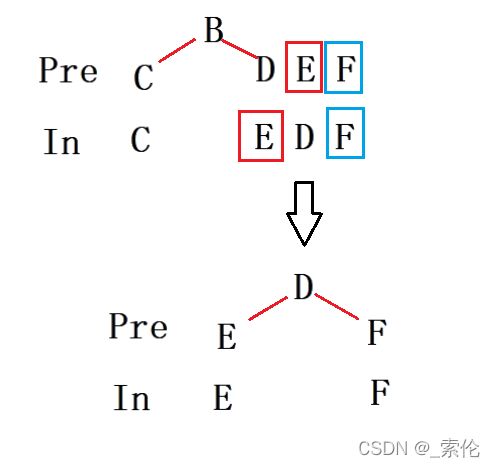数据结构:树的概念 | 二叉树的概念 | 根据前序和中序遍历构建二叉树 | 根据中序和后序遍历构建二叉树
文章目录
- 一、树的概念
-
- 1.名词解释
- 二、二叉树的概念
-
- 1. 二叉树的定义
- 2. 二叉树的性质
- 3.二叉树的存储表示
-
- 3.1 顺序存储表示
- 3.2 链式表示:二叉树链表表示
- 4.链式二叉树的设计
- 5. 二叉树的遍历
- 6.二叉树的构建
-
- 6.1普通构建法
- 6.2 根据先序遍历和中序遍历构建二叉树
- 代码
- 6.3根据中序和后序遍历构建二叉树
一、树的概念
树是由n(n >= 0)个结点组成的有限集合,如果n = 0, 则称为空树,如果n > 0,则
- 有一个特定的称之为根(root)的结点,它只有直接后继,没有直接前驱。
- 除根以外的其他结点划分为m个互不相交的有限集合,每个集合又是一棵树,并且称之为根的子树(subtree),每棵子树的根结点有且仅有一个直接前驱,但可以有0个或多个直接后继。
1.名词解释
- 节点的度:一个节点含有的子树的个数称为该节点的度;
- 树的度:一棵树中,最大的节点的度称为树的度;
- 叶节点或终端节点:度为零的节点;
- 非终端节点或分支节点:度不为零的节点;
- 父亲节点或父节点:若一个节点含有子节点,则这个节点称为其子节点的父节点;
- 孩子节点或子节点:一个节点含有的子树的根节点称为该节点的子节点;
- 兄弟节点:具有相同父节点的节点互称为兄弟节点;
- 节点的层次:从根开始定义起,根为第1层,根的子节点为第2层,以此类推;
- 深度:对于任意节点n,n的深度为从根到n的唯一路径长,根的深度为0;
- 高度:对于任意节点n,n的高度为从n到一片树叶的最长路径长,所有树叶的高度为0;
- 堂兄弟节点:父节点在同一层的节点互为堂兄弟;
- 节点的祖先:从根到该节点所经分支上的所有节点;
- 子孙:以某节点为根的子树中任一节点都称为该节点的子孙。
- 森林:由m (m>=O)棵互不相交的树的集合称为森林;
- 树中任意节点的子节点之间没有顺序关系,这种树称为无序树,也称为自由树。反之是有序树。
二、二叉树的概念
1. 二叉树的定义
一棵二叉树是结点的一个有限集合,该集合或者为空,或者由一个根结点加上两棵称之为左子树和右子树的、两个互不相交的二叉树组成。
2. 二叉树的性质
- 若二叉树的层次从0开始,则在二叉树的第 i 层最多有 2^i 个结点。(i>= 0)。
- 高度为k的二叉树最多有2^(k+1) - 1个结点。(k >= -1)[证明用求等比级数前k项和的公式]。
- 对任何一棵二叉树,如果其叶结点个数为n0,度为2的非叶结点个数为n2,则有n0 = n2 + 1。
- 定义:满二叉树(Full Binary Tree):每一个层的结点数都达到最大值,则这个二叉树就是满二叉树。
- 定义:完全二叉树(Complete Binary Tree):若设二叉树的高度为h,则共有h+1层。除第h层外,其它各层(0 ~h-1) 的结点数都达到最大个数,第h层从右向左连续缺若干结点,这就是完全二叉树。
3.二叉树的存储表示
数据元素之间的关系有两种不同的表示方法:顺序映象和非顺序映象,并由此得到两种不同的存储结构:顺序存储结构和链式存储结构。
数据的存储结构是指数据的逻辑结构在计算机中的表示。
3.1 顺序存储表示
这种表示形式,结点直接有一种关系:
- 如果得知一个结点的编号为 i ,那如果它有左子树,那么左子树编号为(2 * i + 1), 存在右子树的话,右子树编号为(2 * i + 2)。
- 如果得知一个结点编号为 j ,那么其双亲结点编号为(j - 1) / 2;

3.2 链式表示:二叉树链表表示
下图分别是二叉树的树型逻辑图,二叉链表表示图,三叉链表表示图
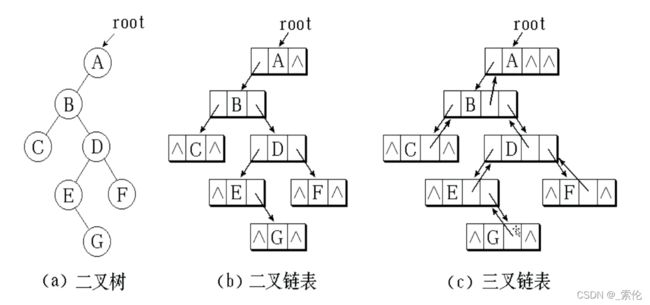
4.链式二叉树的设计
二叉链表方式,没有parent的二叉树
typedef int ElemType;
typedef struct BtNode
{
ElemType data;
struct BtNode* leftchild;
struct BtNode* rightchild;
}BtNode, *BinaryTree;
5. 二叉树的遍历
所谓树的遍历,就是按某种次序访问树中的结点,要求每个结点访问一次且仅访问一次。
设访问根结点记作V; 遍历根的左子树记作L;遍历根的右子树记作 R;
| 遍历规则 | 遍历方式 |
|---|---|
| 前序遍历(先序遍历) | VLR |
| 中序遍历 | LVR |
| 后序遍历 | LRV |
- 前序遍历规则:(Preorder Traversal)
若二叉树为空,则结束;
否则
访问根结点(V);
前序遍历左子树(L);
前序遍历右子树( R )。
void PreOrder(BtNode* root)
{
if (root != NULL)
{
cout << root->data << " ";
PreOrder(root->leftchild);
PreOrder(root->rightchild);
}
}
- 中序遍历规则:(Inorder Traversal)
若二叉树为空,则结束;
否则
中序遍历左子树(L);
访问根结点(V);
中序遍历右子树( R )。
void InOrder(BtNode* root)
{
if (root != NULL)
{
InOrder(root->leftchild);
cout << root->data << " ";
InOrder(root->rightchild);
}
}
- 后序遍历规则:(Postorder Traversal)
若二叉树为空,则结束;
否则
后序遍历左子树(L);
后序遍历右子树®;
访问根结点(V)。
void PastOrder(BtNode* root)
{
if (root != NULL)
{
PastOrder(root->leftchild);
PastOrder(root->rightchild);
cout << root->data << " ";
}
}
6.二叉树的构建
6.1普通构建法
BtNode* Buynode()
{
BtNode* s = (BtNode*)malloc(sizeof(BtNode));
if (NULL == s) exit(1);
memset(s, 0, sizeof(BtNode));
return s;
}
// ABC##DE##F##G#H##
BtNode* CBTree1()
{
BtNode* s = NULL;
ElemType elem;
cin >> elem;
if (elem != '#')
{
s = Buynode();
s->data = elem;
s->leftchild = CBTree1();
s->rightchild = CBTree1();
}
return s;
}
6.2 根据先序遍历和中序遍历构建二叉树
这个过程实际上也是运用了分治策略,不停的划分,直至规模达到最小。
图解:
- 树的逻辑图示,需要在已知先序和中序遍历结果情况下构建
-
通过中序遍历确定出先序遍历第一个元素的位置,那么中序遍历中A的左边就是A的左子树,有五个元素,所以先序遍历也要划分出五个元素作为左子树;剩下的G/H 为右子树。
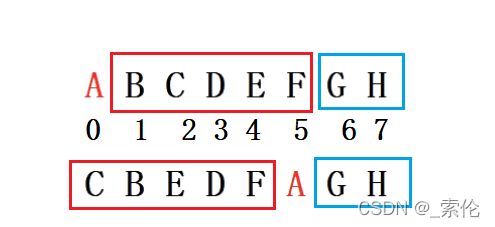
-
在划分出左子树后,拿左子树继续划分,从中序遍历中找到先序遍历的元素B的位置,那么左边就是B的左子树,按照元素个数,先序遍历B的右边划分出相同元素个数作为左子树,剩下的作为右子树。
- 继续划分,直至规模达到最小。
代码
int FindIs(const char* is, int n, char ch)
{
int pos = -1;
for (int i = 0; i < n; ++i)
{
if (is[i] == ch)
{
pos = i;
break;
}
}
return pos;
}
BtNode* CreatePI(const char* ps, const char* is, int n)
{
BtNode* s = NULL;
if (n > 0)
{
s = Buynode();
s->data = ps[0];
int pos = FindIs(is, n, ps[0]);
if (pos == -1) exit(1);
s->leftchild = CreatePI(ps + 1, is, pos);
s->rightchild = CreatePI(ps + 1 + pos, is + 1 + pos, n - pos - 1);
}
return s;
}
BtNode* CreateBinaryTreePI(const char* ps, const char* is, int n)
{
if (ps == NULL || is == NULL || n < 0) return NULL;
else
return CreatePI(ps, is, n);
}
测试用例:
int main(void)
{
char ps[] = { "ABCDEFGH" };
char is[] = { "CBEDFAGH" };
char ls[] = { "CEFDBHGA" };
int n = strlen(ps);
BinaryTree root = NULL;
root = CreateBinaryTreePI(ps, is, n);
PreOrder(root);
cout << endl;
InOrder(root);
cout << endl;
PastOrder(root);
cout << endl;
return 0;
}
6.3根据中序和后序遍历构建二叉树
和上述规则一样,分治策略划分
int FindIs(const char* is, int n, char ch)
{
int pos = -1;
for (int i = 0; i < n; ++i)
{
if (is[i] == ch)
{
pos = i;
break;
}
}
return pos;
}
BtNode* CreateIL(const char* is, const char* ls, int n)
{
BtNode* s = NULL;
if (n > 0)
{
s = Buynode();
s->data = ls[n - 1];
int pos = FindIs(is, n, ls[n - 1]);
if (-1 == pos) exit(1);
s->leftchild = CreateIL(is, ls, pos);
s->rightchild = CreateIL(is + pos + 1, ls + pos, n - pos - 1);
}
return s;
}
BtNode* CreateBinaryTreeIL(const char* is, const char* ls, int n)
{
if (is == NULL || ls == NULL || n <= 0) return NULL;
else
return CreateIL(is, ls, n);
}
测试用例:
int main(void)
{
char ps[] = { "ABCDEFGH" };
char is[] = { "CBEDFAGH" };
char ls[] = { "CEFDBHGA" };
int n = strlen(ps);
BinaryTree root = NULL;
root = CreateBinaryTreeIL(is, ls, n);
PreOrder(root);
cout << endl;
InOrder(root);
cout << endl;
PastOrder(root);
cout << endl;
return 0;
}
